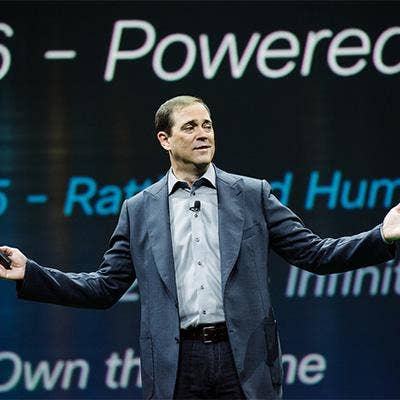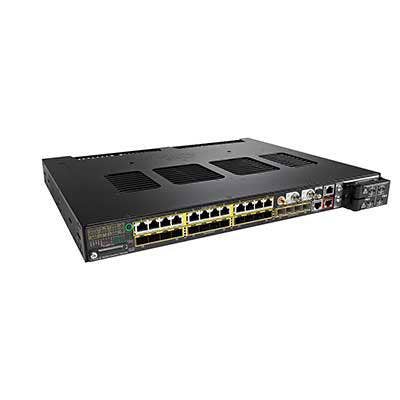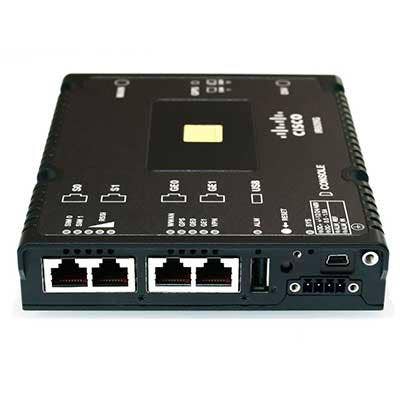10 Takeaways From Cisco's Earnings: CEO Robbins On President-Elect Trump, Security Acquisitions Ahead And More

Earnings Call
Cisco Systems CEO Chuck Robbins didn't shy away from his thoughts about President-elect Donald Trump, the company's declining service provider business, and what's in store for Cisco's booming security business.
Although the San Jose, Calif.-based networking giant beat Wall Street estimates of $12.33 billion in revenue and earnings of 59 cents per share for its first fiscal quarter 2017-- reporting $12.35 billion and 61 cents per share – Robbins addressed several red flags. The political environment in the U.S. and abroad was an unusually hot topic during the earnings call, with Robbins expressing optimism for the future regarding President-elect Donald Trump.
Here are the 10 biggest takeaways from Cisco's earnings call Wednesday.

Robbins On Trump
Although his predecessor John Chambers, chairman of the board for Cisco, and Hewlett Packard Enterprise CEO Meg Whitman were vocal in their support for Democratic presidential candidate Hillary Clinton, Robbins was relatively quiet regarding politics. During the earnings call, Robbins expressed his optimism for the future of his company under Trump.
"I think President-elect Trump appears to be very business-oriented and is very focused on driving the U.S. economy, and anytime the U.S. economy improves that's certainly good for us," said Robbins. "Post-election, I think that most CEOs that I talk to, we are pragmatic about the results, and now we are all focused on the policy issues that matter to each of our companies."

Service Provider Segment Dragging Down Revenue
Robbins said Cisco has been hit hard by a spending hiatus from service providers as they decide where to spend their CapEx dollars. The CEO said Cisco's service provider business represents roughly 25 percent of the company's overall business, and the segment was down 12 percent in its first fiscal quarter 2017. Robbins said the lack of spending by service providers is due to the market waiting to see how the political landscape and policies play out.
"There are some service providers around the world – not necessarily in the U.S. – that are dealing with political dynamics and potential regulatory issues that just aren't clear," said Robbins. "I have not heard a lot of U.S.-based service providers who have paused directly related to the election, but I do believe that the regulatory environment in the U.S. is obviously in flux around the telecom environment and that could have implications for the service providers, and some of them may wait and see how that plays out."

More Security Acquisitions Ahead
Cisco has been on in acquisition spree since the company said in May 2015 that Robbins would succeed Chambers as CEO. Security has been a major M&A focus for Robbins, with Cisco spending well more than $1 billion acquiring security vendors including Lancope, Portcullis Computer Security, OpenDNS and the latest purchase of CloudLock in June. Robbins said Cisco would make even more acquisitions in the security space.
"You can assume that we are actively continuing to scan the landscape relative to acquisitions that fit within the architecture that bring new capabilities," said Robbins. "When I took the [CEO] role … there was a little pent-up demand from some companies that the teams wanted to move on. And we moved relatively quickly in the first year or so, but I wouldn't assume that that suggests that there's no more activity that we will see there -- I think we will."

Weak Q2 Guidance
During the earnings call, Cisco provided a weak revenue guidance for its 2017 second fiscal quarter, projecting revenue to decline 2 percent to 4 percent year over year. The networking giant's shares have dipped more than 5 percent, to $29.66 per share, since the earnings were released Wednesday. The disappointing guidance is due to Cisco's continued decline in service provider sales, according to Robbins.
"If you look at our guidance, let me be clear, it's predominantly the service provider weakness and the overall CapEx challenges that we've seen in [service providers]," said Robbins. "Right now, I think there's a unique set of characteristics particularly in the [service provider] space where you have the overarching macro uncertainty in the economy, which I think has led to the service provider CapEx weakness that has been reported all year, as well as you have the political and regulatory environments that are somewhat uncertain both in the U.S. and around the world."

Security Revenue Continuing To Surge
Security was the shining star in Cisco's earnings, with the business increasing 11 percent year over year to $540 million. This was Cisco's fourth consecutive quarter of double-digit growth in security. Robbins said Cisco was the No. 1 global market leader in security with a run rate of well more than $2 billion.
"Our competitive position in security is growing stronger as our integrated architecture approach and best-of-breed portfolio resonates with our customers," said Robbins. "In fact, we're the only company with security product revenue exceeding a $2 billion annualized run rate with double-digit growth."

Switching Declines
The company's biggest revenue-generating market segment is switching, which was down 7 percent to $3.7 billion for its first fiscal quarter 2017, compared with a year ago. Cisco's bread-and-butter switching business has been rocky over the past few quarters.
For its previous fourth fiscal quarter 2016, Cisco's switching grew 2 percent year over year to $3.8 billion. The company reported a 3 percent drop in switching to $3.45 billion for its third fiscal quarter 2016.

Routing Bounces Back
After two consecutive quarters of declining routing sales, Cisco had a solid first fiscal quarter of $2.1 billion in router revenue, representing an increase of 6 percent year over year.
The company reported a 6 percent year-over-year decline in routing product sales to $1.87 billion for its fourth fiscal quarter 2016, as well as a 5 percent decline in routing during its third fiscal quarter 2016.

Mixed Bag In Collaboration
Collaboration was front and center during Cisco Partner Summit 2016 in San Francisco, with several new launches as well as a new subscription offering for Cisco Spark.
Although Cisco's collaboration business has been on a hot streak for the past few consecutive quarters, for its first fiscal quarter 2017 it declined 3 percent year over year to $1.01 billion. Kelly Kramer, Cisco's chief financial officer, said although the collaboration revenue declined, there was still a "solid order growth."
"The revenue decrease was driven by TelePresence and unified communications endpoint partially offset by strong growth of 10 percent in conferencing as we see more customers each quarter committing to WebEx," said Kramer during the earnings call. "We saw good momentum again in the transition to subscriptions and SaaS offers with deferred revenue up 14 percent."

Data Center Declines 3 Percent
One red flag during the earnings call was a 3 percent year-over-year drop in Cisco's data center business – which includes Cisco Unified Computing System – to $834 million. Cisco said the decline was due to the market shift from blade to rack.
"In UCS there's been a fundamental shift in the data center," Robbins said. "We've talked about the rack technology and in hyper-converged we have some early success with [Cisco's hyper-converged solution] HyperFlex."
Cisco recently took an aggressive stance against server rival HPE by launching a new HPE Competitive Promo aimed at boosting UCS server wins by enabling Cisco channel partners to win business in tightly competitive deals.

Recurring Revenue Rising
Cisco's portion of product deferred revenue related to recurring and subscription businesses grew a whopping 48 percent year over year to $3.8 billion. Robbins said Cisco's rising subscription-based business resulting in deferred revenue growth of 39 percent in its security business compared with a year ago.
Total deferred revenue grew 12 percent, with products up 19 percent and services up 8 percent. "We're making progress each quarter on our goal of driving more recurring revenue," said Kramer.